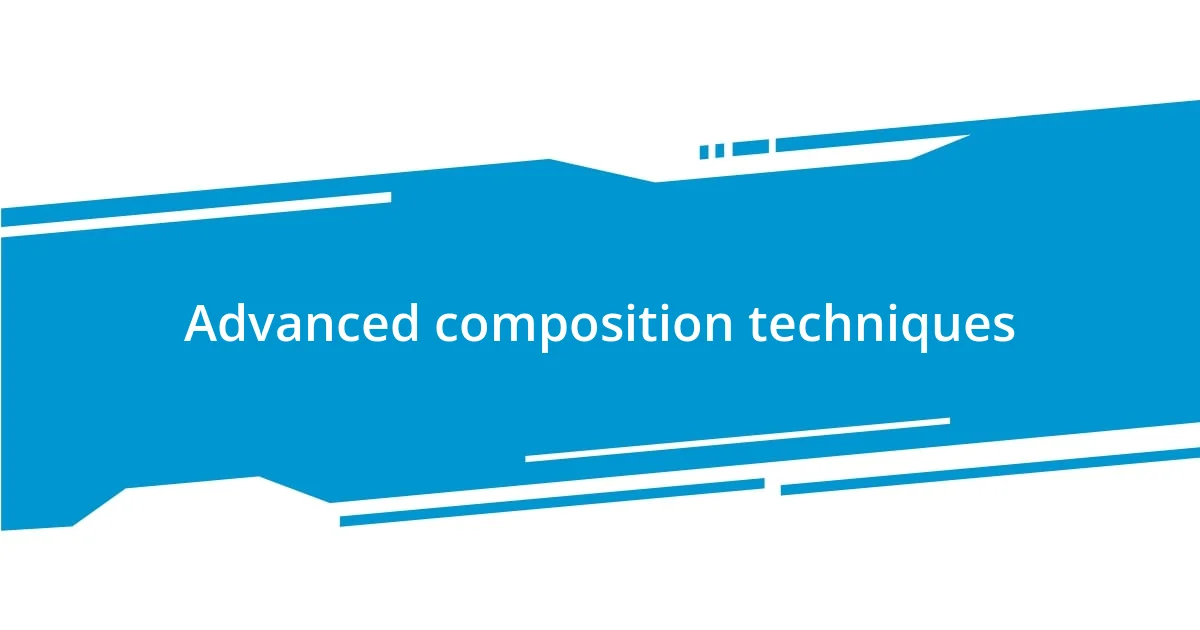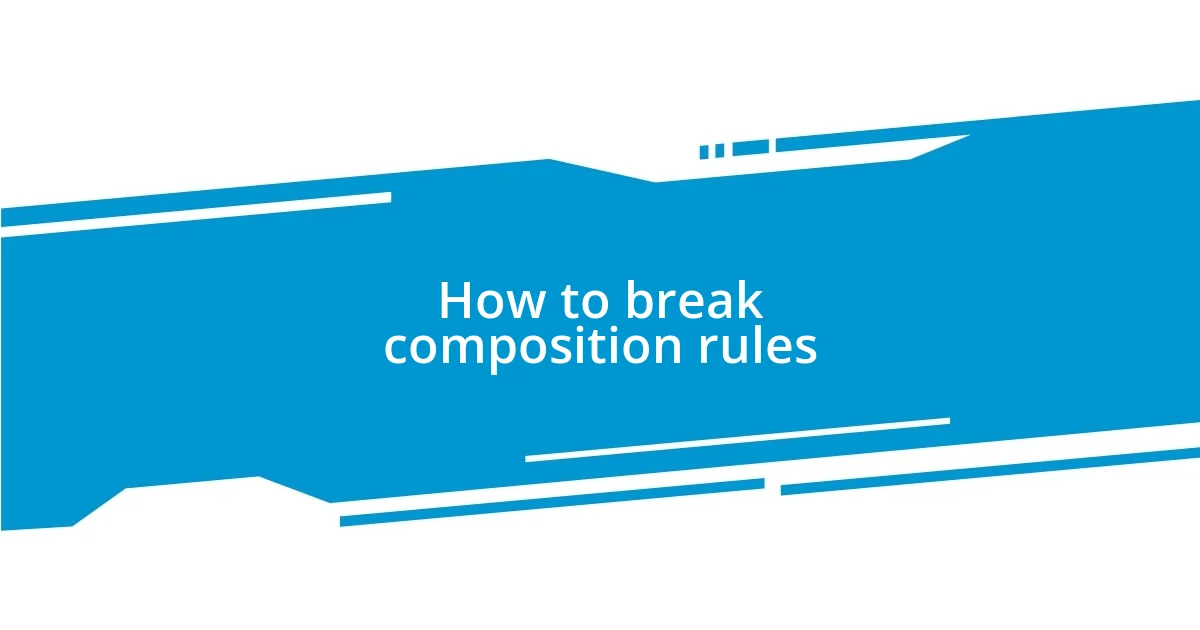Key takeaways:
- Understanding and applying composition techniques, such as the rule of thirds and leading lines, enhances the visual dynamism and storytelling in photography.
- Breaking traditional composition rules intentionally can lead to unique, emotionally impactful images that resonate more with viewers.
- Utilizing tools like camera settings, photo editing software, and grid overlays can significantly improve the composition and overall quality of photographs.

Understanding photo composition
Understanding photo composition is about creating a visual balance that draws the viewer in. I remember my early days as a photographer when I would instinctively place subjects in the center of the frame. It felt natural, but looking back, I realize it often lacked dynamism. Have you ever felt that same urge? Breaking away from the center can lead to more engaging images.
Consider the rule of thirds, a technique that encourages you to divide your frame into nine equal sections. This simple grid provides a way to guide the viewer’s eye across the photo. When I first experimented with this rule, I found myself captivated by how much energy the compositions had. Each time I aligned a subject along the gridlines, it felt like I was breathing life into my images.
Moreover, composition is not just about placing elements in a frame; it’s also about telling a story. I once captured a street scene where a child was chasing a balloon amidst busy adults. The chaotic background contrasted beautifully with the child’s joyful innocence, illustrating a narrative that I hadn’t planned. Have you encountered moments like this where your lens captured more than just a scene? Those are the times when you truly understand the essence of photo composition.

Importance of composition in photography
Composition in photography is crucial because it shapes how viewers interpret an image. There’s a certain thrill I experience when I meticulously arrange elements to create harmony or tension in a frame. For instance, while capturing a sunset, I strategically placed a silhouette of a tree off to the side, letting the vibrant colors paint the sky. That placement transformed the photo from a standard sunset into a captivating moment that evoked peace and wonder.
- Composition guides the viewer’s eye and creates a focal point.
- It helps in conveying emotions and narratives, allowing the viewer to connect with the image on a deeper level.
- By manipulating space and balance, photographers can evoke specific feelings, from serenity to excitement.
- Strong composition can elevate ordinary scenes into extraordinary photographs, capturing attention and sparking interest.

Basic rules of composition
When delving into the basic rules of composition, it’s essential to grasp their significance in shaping impactful images. One rule that resonates with me is leading lines. I often seek out natural lines—like rivers or roads—that draw the viewer’s eye toward the main subject. On one occasion, I noticed a pathway winding through a forest, perfectly framing a stunning sunset. Those lines guided the viewer in, making the image feel immersive and inviting.
Another vital aspect of composition is the use of negative space. This technique involves leaving empty areas in your image to highlight your subject effectively. I once photographed a lone lighthouse on a rocky shore, deliberately allowing the sky and ocean to occupy most of the frame. The result was not only a powerful focal point but also an emotional sense of isolation that lingered with me long after the moment. Have you ever employed negative space to create depth within your photos?
Finally, remember the power of symmetry and patterns. These elements can evoke a sense of tranquility and balance in your compositions. I discovered this while capturing urban architecture; the repeating windows of a building created a rhythmic pattern. Aligning my shot symmetrically allowed for an aesthetically pleasing image that felt harmonious. Symmetry can elevate a photo from average to striking, presenting a whole new perspective.
| Rule | Description |
|---|---|
| Rule of Thirds | Divides the frame into nine sections, guiding eye movement. |
| Leading Lines | Utilizes natural lines to draw attention to the subject. |
| Negative Space | Emphasizes the subject by surrounding it with empty space. |
| Symmetry | Creates balance and harmony through equal visual elements. |

Advanced composition techniques
One advanced technique I can’t stress enough is the use of depth. By layering elements within the frame, I create a sense of three-dimensionality that captivates viewers. I recall a time when I photographed a flower garden; I focused on a vibrant bloom in the foreground while softly blurring the background flowers. This not only drew attention to my main subject but also provided context, making the photo feel lush and alive. Have you ever experimented with depth to bring your images to life?
Another fascinating technique is to play with perspective. Changing your viewpoint can offer truly unique compositions. I once crouched low to capture a child’s joyful jump on the beach, which emphasized the vastness of the ocean behind them. The shot conveyed a sense of freedom and exhilaration that was hard to match. It made me think about how shifting our perspective—even just slightly—can completely transform our storytelling in photography.
Finally, incorporating contrasting elements can add a dynamic feel to your images. I vividly remember shooting at a bustling market where vibrant fruits lined up against weathered wooden stalls created a stunning contrast. This deliberate juxtaposition not only guides the viewer’s eyes but also invokes a blend of emotions, from nostalgia to excitement. Have you found opportunities to explore contrast in your own photography, sparking a richer narrative?

How to break composition rules
Breaking composition rules can lead to exciting and unexpected results in photography. Sometimes, I intentionally ignore the rule of thirds, placing my subject smack in the center of the frame. I remember capturing an abandoned train station, with the rusty train directly in the middle—this bold choice created a sense of isolation, emphasizing the dereliction around it. Have you ever tried centering your subject to evoke a stronger emotional response?
Embracing chaos can also take your images to another level. When I shot a bustling street market, I decided to capture the entire scene in one frame, ignoring any notions of symmetry or neatness. The result was a delightful whirlwind of colors and faces—it felt like I could step right into the vibrancy of the moment. How often do we allow ourselves to capture disorder in a way that tells a dynamic story?
Lastly, don’t shy away from experimenting with off-kilter angles. I had a memorable experience photographing a pet during playtime; I crouched down and tilted my camera, capturing the dog mid-leap against an unusual backdrop. That unconventional angle transformed an ordinary moment into something truly playful and energetic—showcasing the spirit of my furry friend. Have you ever considered how a slight tilt in your composition can inject life into a still image?

Tools for improving composition
When it comes to tools for improving composition, having a reliable camera with manual settings is crucial. I remember my first experience adjusting the aperture for the first time; I was astounded by how much control I had over the depth of field. It’s liberating to shape the focus, and it truly transformed the way I approach a subject. Have you ever noticed how a simple tweak in your camera settings can completely alter the mood of your shot?
Beyond the technical gear, I also find that photo editing software is an invaluable tool for enhancing composition. Using programs like Lightroom allowed me to fine-tune the crop and adjust the lighting, bringing out details that were nearly hidden in the shadows. There was a moment when I edited a sunset shot; the colors popped more vividly after adjustments, making the clouds look like they were truly on fire. Have you explored the potential of digital editing to refine your compositions and storytelling?
Don’t underestimate the power of grid overlays, either. Grid lines can act as a guide to ensure your elements are well-placed within the frame. I often turn on the grid feature in my camera, and it helps me visualize my shot before I even press the shutter. The first time I used it while photographing a cityscape, I aligned the horizon perfectly. It made a significant difference in the overall impact of the image. Implementing these simple tools can elevate the quality of your work; have you tried using grids to assist your compositions?

Practicing composition in different settings
Practicing composition in different settings is incredibly rewarding. I recall my adventure at a serene lakeside during golden hour; the soft light transformed everything around me. I experimented with reflections in the water, framing the trees and mountains upside down, creating a dreamy symmetry. Have you ever noticed how an unusual perspective can elevate a tranquil scene?
In busy urban settings, I’ve learned to embrace the rhythm of the streets. One day, while strolling through a lively neighborhood, I seized the opportunity to capture the hustle and bustle of pedestrians and cyclists. I positioned myself at the intersection where multiple paths crossed, creating a dynamic composition filled with movement and energy. Have you felt that thrill when capturing the essence of a place just as it comes alive?
Nature presents a whole new set of challenges. During a hiking trip, I focused on composing shots of wildflowers amongst towering trees. I crouched down low, using the flowers to frame a majestic peak in the background. That angle added depth and storytelling to my image, making the viewer feel like they were peering through my lens. Have you explored how the environment can shape your compositions and tell a story?
















